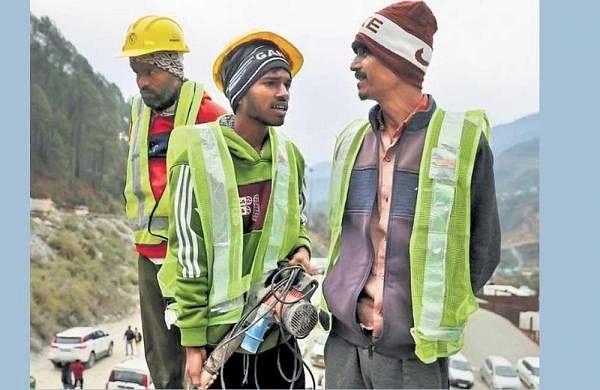Express News Service
LUCKNOW/DEHRADUN: Nestled in the heart of the historic Bundelkhand region, Jhansi has recently brought its ‘rat-hole miners’ to the forefront, illuminating their indispensable role in the most challenging situations.
These skilled individuals, beyond mere headlines, demonstrated their prowess by rescuing 41 lives from a choked tunnel in Uttarakhand, employing techniques echoing a centuries-old tradition. In a crisis where a cutting-edge US-made auger machine fell short, the ‘rat-hole’ mining expertise emerged as the saviour. Led by Prasad Lodi from Jhansi, a team of six adept ‘rat miners,’ armed with only hammers, trowels, and shovels, joined forces with the Indian Army, NDRF, and SDRF rescue teams. Together, they successfully breached the rocky terrain, bringing trapped miners to safety after a harrowing 17 days.
Colonel Deepak Patel, leading the Silkier rescue operation, emphasised the collective efforts, highlighting the pivotal role played by these “rat miners” in crucial moments. “It was the result of collective efforts of all, every rescue worker contributed significantly to it, definitely the role of “rat miners” was decisive at the last minute”
Rat-hole mining, deeply rooted in antiquity, involves manually extracting resources through narrow horizontal passages. Historically, this method played a crucial role in constructing 16th-century temples in the Bundelkhand region, renowned for its historical monuments, forts, and temples.
The prevalence of rat-hole mining in Jhansi is attributed to its rocky plateau with a bedrock of hard granite, making conventional drilling challenging. Earth scientists note that this primitive method is employed by rock cutters to create wells and ponds where explosives cannot be used due to the hard rock composition.
Local sources reveal that ‘rat miners,’ colloquially known as ‘khagars,’ hail from various communities. From quarrying to underpass creation, and even well and pond construction, their expertise spans a wide spectrum using tools such as hammers and shovels.
From obscurity to hogging limelight
Rat miners, popularly called ‘khagars’ in the Bundelkhand region, come from different communities such as Ahirwar, Kushwaha, Lodhi, Sahariya and Koris
Six rat miners from Jhansi, equipped with hammers, trowels and shovels, took part in rescue work
Rat-hole mining a family profession
Rat-hole miners are capable of breaking rocks up to 10 quintals with hammers and shovels
Rat-hole mining technique was used in building temples in 16th century in Bundelkhand region
Follow channel on WhatsApp
LUCKNOW/DEHRADUN: Nestled in the heart of the historic Bundelkhand region, Jhansi has recently brought its ‘rat-hole miners’ to the forefront, illuminating their indispensable role in the most challenging situations.
These skilled individuals, beyond mere headlines, demonstrated their prowess by rescuing 41 lives from a choked tunnel in Uttarakhand, employing techniques echoing a centuries-old tradition. In a crisis where a cutting-edge US-made auger machine fell short, the ‘rat-hole’ mining expertise emerged as the saviour. Led by Prasad Lodi from Jhansi, a team of six adept ‘rat miners,’ armed with only hammers, trowels, and shovels, joined forces with the Indian Army, NDRF, and SDRF rescue teams. Together, they successfully breached the rocky terrain, bringing trapped miners to safety after a harrowing 17 days.
Colonel Deepak Patel, leading the Silkier rescue operation, emphasised the collective efforts, highlighting the pivotal role played by these “rat miners” in crucial moments. “It was the result of collective efforts of all, every rescue worker contributed significantly to it, definitely the role of “rat miners” was decisive at the last minute”googletag.cmd.push(function() {googletag.display(‘div-gpt-ad-8052921-2’); });
Rat-hole mining, deeply rooted in antiquity, involves manually extracting resources through narrow horizontal passages. Historically, this method played a crucial role in constructing 16th-century temples in the Bundelkhand region, renowned for its historical monuments, forts, and temples.
The prevalence of rat-hole mining in Jhansi is attributed to its rocky plateau with a bedrock of hard granite, making conventional drilling challenging. Earth scientists note that this primitive method is employed by rock cutters to create wells and ponds where explosives cannot be used due to the hard rock composition.
Local sources reveal that ‘rat miners,’ colloquially known as ‘khagars,’ hail from various communities. From quarrying to underpass creation, and even well and pond construction, their expertise spans a wide spectrum using tools such as hammers and shovels.
From obscurity to hogging limelight
Rat miners, popularly called ‘khagars’ in the Bundelkhand region, come from different communities such as Ahirwar, Kushwaha, Lodhi, Sahariya and Koris
Six rat miners from Jhansi, equipped with hammers, trowels and shovels, took part in rescue work
Rat-hole mining a family profession
Rat-hole miners are capable of breaking rocks up to 10 quintals with hammers and shovels
Rat-hole mining technique was used in building temples in 16th century in Bundelkhand region
Follow channel on WhatsApp





